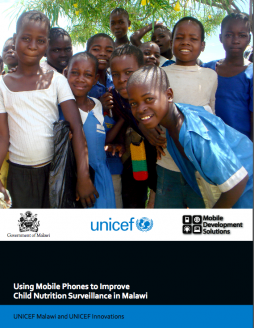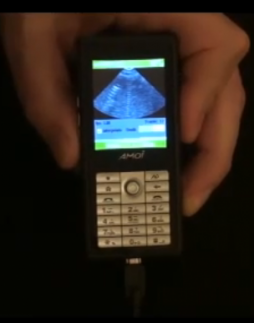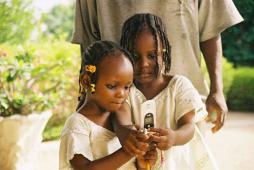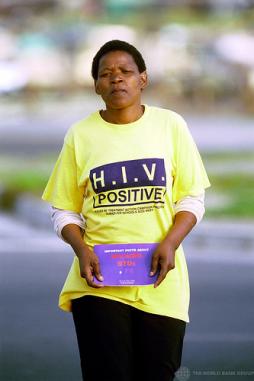Communication and Training of Healthcare Personnel
Posted by LeighJaschke on Jun 27, 2009
The Case for SmartTrack data sheet 2153 Views
Author:
Levine, Brian; Hopkins, Mary Ann; Rapchack, Barbara; Subramanian, Lakshminarayanan
Abstract:
Nearly 40 million people in Africa suffer from HIV/AIDS. African governments and international aid agencies have been working to combat this epidemic by vigorously promot- ing Highly Active Anti-Retroviral Therapy (HAART) programs. Despite the enormous subsidies offered by governments along with free Anti-RetroViral (ARV) drugs supplied by agencies, the introduction and implementation of HAART programs on a large scale has been limited by two fundamental problems: (a) lack of adherence to the ARV therapy regimen; (b) lack of accountability in drug distribution due to theft, corruption and counterfeit medication. In this paper, we motivate the case for SmartTrack, a telehealth project which aims to address these two problems facing HAART programs. The goal of SmartTrack is to create a highly reliable, secure and ultra low-cost cellphone-based distributed drug in- formation system that can be used for tracking the flow and consumption of ARV drugs in HAART programs. In this paper, we assess the potential benefit of SmartTrack using a detailed needs-assessment study performed in Ghana, using interviews with 516 HIV-positive rural patients in a number of locations across the country. We find that a system like SmartTrack would immensely benefit both patients and healthcare providers, and can ultimately lead to improved patient outcomes and better accountability.
Starts page 458.
Posted by LeighJaschke on Jun 26, 2009
ICTD for Healthcare in Ghana: Two Parallel Case Studies data sheet 2081 Views
Author:
Luk, Rowena; Zaharia, Matei; Ho, Melissa; Levine, Brian; Paul M.
Abstract:
This paper examines two parallel case studies to promote remote medical consultation in Ghana. These projects, initiated independently by different researchers in different organizations, both deployed ICT solutions in the same medical community in the same year. The Ghana Consultation Network currently has over 125 users running a Web-based application over a delay-tolerant network of servers. OneTouch MedicareLine is currently providing 1700 doctors in Ghana with free mobile phone calls and text messages to other members of the medical community. We present the consequences of (1) the institutional context and identity of the investigators, as well as specific decisions made with respect to (2) partnerships formed, (3) perceptions of technological infrastructure, and (4) high-level design decisions. In concluding, we discuss lessons learned and high-level implications for future ICTD research agendas.
Posted by LeighJaschke on Jun 25, 2009
HIV Health Information Access using Spoken Dialogue Systems: Touchtone vs. Speech data sheet 1633 Views
Author:
Grover, Sharma A.; Plauché, Madelaine, Bernard, Ethienne; Kuun, Christiaan.
Abstract:
This paper presents our work in the design of a
SDS for the provision of health information to caregivers of HIV
positive children. We specifically address the frequently debated
question of input modality in speech systems; touchtone versus
speech input, in a new context of low literacy users and a health
information service. We discuss our experiences and fieldwork
which includes needs assessment interviews, focus group sessions,
and user studies in Botswana with semi and low-literate users.
Our results indicate user preference for touchtone over speech
input although both systems were comparable in performance
based on objective metrics.
Posted by LeighJaschke on Jun 23, 2009
CDC - Mobile Health Initiatives data sheet 2002 Views
Author:
Krishnamathury, Ramesh S.
Abstract:
This presentation provides insight into current mobile health initiatives and the current global health landscape. The presentation outlines the Thai system as an example of health informatics in resource poor setting, and introduces areas of global health and SMS application. Rwanda's implementation of TRACnet and public health for monitoring of the national HIV/AIDS program is used as an example. The presentation focuses on developing a framework for mobile computing in global health, including: standardizing Health Metrics (HMN), standardizing approaches, and integrating SSM into broader public health information systems and enterprise health information architecture. The report concludes with a look into SMS applications in emergency response, program monitoring and reporting, and patient monitoring. Key challenges are listed.
Posted by LeighJaschke on Jun 22, 2009
Technology for Early Disease Detection and Rapid Disaster Response: InSTEDD data sheet 1782 Views
Author:
Kass-Hout, Taha; Marcus, Mary-Jane
Abstract:
This presentation provides an overview of the InSTEDD Global Platform for Early Disease Detection, Reponse, and Evaluation. The summary includes reviews the proportion of infections detected and proposes addressing these challenges by adopting a social network and cognitive model approach. The approach facilitates: Early identification of potential health threats and verification, assessment, and investigation of threats in order to recommend measures (public health and other) to control them. The presentation describes the indicator and event-based hybrid surveillance approach and gives two examples of collaborative testing in the field.
Posted by KatrinVerclas on Jun 20, 2009
Reported by Leigh Jaschke and Melissa Loudon.
This spring, UNICEF Malawi and the UNICEF Innovations Team deployed RapidSMS to monitor child growth and nutrition. We wrote about it previously here.
Now there is a detailed report (pdf), evaluating the effort (pdf). The report, released on June 16th, was issued by Columbia University's School of Public Policy and Affairs (SIPA), UNICEF Malawi, UNICEF's Innovations team, and Mobile Development Solutions (MDS).
The report details the findings of the deployment, and outlines recommendations for the future use of SMS in Malawi. Raymond Short of Mobile Development Solutions says that,
“while there have been innumerable ICT development applications introduced recently, there have not been many independent studies of their efficiency”.
Posted by LeighJaschke on Jun 20, 2009
Mobile Services Evolution 2008-2018 data sheet 2792 Views
Abstract:
This paper takes a look at the potential evolution of mobile technology and services over the next ten years and discusses an mServices framework for building and deploying diverse mobile services. The paper also looks at the challenges of such an endeavor and the steps needed to achieve the vision.
The report suggests how mobile devices will be used for much more than voice communications in the coming years in mHealth, mGovernance, mEnterprise, and mPublic Safety. Supporting the projections are: a mapping of mobile penetration, mobile ecosystem dynamics and deployment and adoption of mobile technology in the developing world. The report summarizes the building blocks of a mobile services platform and concludes with an emphasis on public-private partnership and the innovative business models that will accompany these changes.
Posted by LeighJaschke on Jun 19, 2009
Landscape Analysis of mHealth in the Global South data sheet 1703 Views
Abstract:
The “mHealth in the Global South: Landscape Analysis” report by Vital Wave Consulting examines in detail the current mHealth landscape and provides an in depth overview of mHealth's scope, it's impact on healthcare, and existing opportunities across developing regions. The report also analyzes critical success factors for making mHealth more widely availab;e through sustainable implementations.
Posted by LeighJaschke on Jun 19, 2009
Healthcare Unplugged: The Evolving Role of Wireless Technology data sheet 1865 Views
Abstract:
This report is based on interviews with more than two dozen researchers, clinicians, and application developers, and on a review of a broad range of published papers and articles, web resources, and other materials.The report begins with an overview of the global wireless revolution in term of who is using the technology and how the technology is evolving. It then describes a variety of wireless health care applications that are currently available or under development: considers the impact these advances could have on potential providers, pateints and payers; and discusses key unresolved issues. The report concludes with a brief look at some likely future developments and their implications for healthcare.
Posted by LeighJaschke on Jun 18, 2009
Using Mobile Phones to Improve Child Nutrition Surveillance in Malawi data sheet 3593 Views
Author:
UNICEF Malawi, UNICEF Innovations, Mobile Development Solutions
Abstract:
This study is the result of a collaboration between Columbia University’s School of International and Public Affairs, UNICEF Malawi, and UNICEF’s Division of Communications Innovations Team in an attempt to use mobile communication devices to facilitate the surveillance of child nutrition in Malawi. As part of the pilot study, health workers at three district growth monitoring clinics were trained to submit child nutrition data via mobile phone SMS (text messages). Using an open-source software platform (RapidSMS), this data was received by a central server and automatically analyzed for indicators of child malnutrition. Health workers received instant feedback messages confirming the information sent and provided additional directions if malnutrition was indicated by the data received. Finally, a website was created to provide the Malawian government and other stakeholders real-time access to this data and its analysis. The report details the pilot study’s findings and outline recommendations for the future use of RapidSMS in Malawi.
This pilot study yielded a number of findings that may be applicable to other development projects using similar mobile phone technology. The results of this particular program included: Significant reduction in data transmission delay compared to Malawi’s current paper-based system. increase in data quality reported by health workers, elimination of the need for time-consuming manual data-entry, increased two-way flow of information between stakeholders at the national government level and health workers in the field, increased system and personnel monitoring capabilities, and elimination of costs related to transporting paper forms and manually entering data.
However, technology can only aid development within a limited scope. The true value of this innovation will be dependent on several other factors, including the integration of RapidSMS into the larger context of health activities and policy making in Malawi; the willingness of the Government of Malawi to take ownership of the platform; the ability to build and develop local technical capacity; and the maintenance of training and monitoring at all levels of participation.
Posted by LeighJaschke on Jun 18, 2009
Towards the Development of an mHealth Strategy: A literature review data sheet 2568 Views
Author:
Mechael, Patricia N.; Slonininsky, Daniela
Abstract:
This report maps out what is known about a broad range of mobile and wireless technologies and the contributions that they are making towards achieving health care objectives in low and middle income countries.
The report is divided into six sections: overview of mHealth as a critical domain within eHealth, review of health-related applications associated with mobile technologies, exploration of how various technologies are being used to achieve health objectives, documentation of key leaders and partnerships that have emerged to test and expand mHealth in low and middle income countries, critical considerations based on early initiatives and research, and key recommendations for next steps in the area of mHealth.
The report is based on an intensive study of peer-reviewed literature, program evaluation and industry reports, grey literature, and communication with a broad range of stakeholders. Recommendations include that key mHealth stakeholders focus their energies on the testing and scale-up of interventions. These interventions should show promise in achieving the key health outcomes as laid out by the Millenium Development Goals (MDG's) for health. Further, the report recommends that the World Health Organization (WHO) serves as a convener of key partners and a broker of mHealth strategies, information, and frameworks.
The potential of mobile communication technologies to reduce professional isolation, facilitate the work of overstretched human resources, and yield cost savings and efficiency is recognized. However, the report concludes that technological solutions should be designed according to local realities and meet local needs in away that practically and measurably contributes to the MDG's or health.
Posted by LeighJaschke on Jun 15, 2009
The Role of Mobile Phones in Increasing Accessibility and Efficiency in Healthcare data sheet 2990 Views
Author:
Atun, Rifat A.; Greene, Stephen A.; Morris, Stephen; Thomas, Lucy; McKee, Martin; Franklin, Victoria; Coker, Richard; Urganci, Ipek G.; Samyshkin, Yevgeniy; Sittamplalam, Soalen R.
Abstract:
The Vodaphone Policy Paper Series No. 4 is a compilation of reports that look specifically at the contribution of Mobile phones in healthcare. The reports focus on the basic voice and text potential of mobile phones and identify opportunities for improved efficiency and effectiveness in service delivery where service provider-customer communication is important.
Moving the debate forward are reports made by experts who provide an analysis of the healthcare situation and their view on the contribution of Mobile phones in healthcare. Their analysis highlights three areas where mobile applications offer potential value to healthcare providers: Tracking inefficiencies in service provision by improving communication between service providers and users, improving the effectiveness of healthcare (and the risk of serious complications) through improved self-management and monitoring of patients with chronic conditions, and increasing the ability of hard-to-reach groups to access healthcare services by reducing the barriers of inconvenience, confidentiality, and privacy.
The Office of Health Economics (OHE) Consulting, contribute an overall analysis of healthcare costs in Western Europe and an assessment of potential applications of mobile phones in that context. Health Economists at the Tanaka Business School of Imperial College in London, NHS Direct, the University of Dundee and other institutions provide a series of case studies.
Reports included:
Upward Trend in Healthcare Spending
Analysis of Calls to NIH Direct
Review of Characteristics and Benefits of SMS in Delivering Helthcare
Potential Uses of SMS Applications for the Control of Tuberculosis
Use of Mobile Technologies to Enhance Control of Type 1 Diabetes in young People: Economic Evaluation
Posted by KatrinVerclas on May 04, 2009
Take a low-cost ultrasound probe, a Windows mobile phone, and the skills of two scientists at Washington University in St Louis in the United States, and you get the world's first mobile-phone ultrasound instrument.
USB-based ultrasound probes have been around since 2005, offering a much cheaper and more portable alternative to larger ultrasound machines. Probes provide increasingly high-quality imaging for a tenth of the cost. A typical, portable ultrasound device costs around $20,000, while USB probes sell for around $2,000 right now - and the price is declining. Probes are ideally suited for first-responders and for primary care in developing countries, for example.
The small probes are connected to a phone with a USB cord that have been, typically, connected to a laptop for displaying the images. But carrying around laptops for transmitting images is not an option in many clinics in developing countries for lack of consistent electricity, heat, and lack of Internet access.
Posted by KatrinVerclas on Oct 07, 2008
How are social movements in the global South taking advantage of the ubiquity of mobile phones? Melissa Loudon, a researcher now working at the University of Capetown, looked at how the South African Treatment Action Campaign (TAC) is using mobiles in their work to advocate for a comprehensive HIV/AIDS policy in South Afric, and wrote this article based on her research.
Kevin Gillan, a researcher on the British anti-war movement, describes social movements as “definitionally collective and communicative”. Co-ordination of protest action, mobilisation of financial resources and strategic interaction would be almost unthinkable without information and communication technologies (ICTs). Although the importance of mass media to social movements has long been recognised, new ICTs burst on the scene in 1999 when demonstrators in the 'Battle of Seattle' orchestrated unprecedented protest action using mobile phones, email and the Internet. Ever since, ICTs have been accepted as an integral part of mobilisation in the North.
Posted by KatrinVerclas on Aug 18, 2008
Civil society can play a large role in getting people digitally connected, say the co-editors of the new book 'ICT Infrastructure in Emerging Asia: Policy and Regulatory Roadblocks'.
"However, in order to reap the full benefits from connectivity in a long-lasting manner, underlying issues of policy, affordability and technology need to be addressed," LIRNAsia's Executive Director Rohan Samarajiva and co-editor of the book with Ayesha Zainudeen, told Mobileactive.org in an email interview.
Currently Asia is the fastest growing region in the world in terms of connectivity. Between 1984 and 1993, the Asia Pacific as a region overtook the other regions of the world (mainly due to mobiles), and it continues to grow, he noted.
"The book looks at the recent experiences of some countries in emerging Asia that are improving connectivity.
Posted by CorinneRamey on May 25, 2008
Roberta Lamptey Nartey, a family health practitioner in Ghana, used to rely on the walkie talkies of the security guards to communicate between hospitals where she worked. Once she wanted a woman who had had a severe asthma attack transferred from the Korle Bu Polyclinic to the surgery unit of another hospital. Nartey left a message with the night nurses to transfer her patient and wrote a note in the patient's chart, but to her chagrin, the asthmatic patient never appeared in the surgery unit. "I told the security man at the Surgical Unit to send a message to the security man at the polyclinic using his walkie talkie," Nartey wrote. "The security man at the polyclinic then went to the female ward at the polyclinic to remind the nurses on the morning shift that I was waiting at the Surgery Ward." After several layers of communication, Nartey's patient finally made it to surgery.




